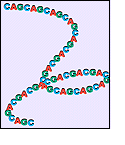|
 Previous Event | Next Event Previous Event | Next Event 
1989: Microsatellites, New Genetic Markers
 A microsatellite is a stretch of DNA made of a two to four base-pair long sequence that is repeated in tandem – e.g. a stretch of DNA that looks like this: CAGCAGCAGCAGCAGCAGCAG. A microsatellite is a stretch of DNA made of a two to four base-pair long sequence that is repeated in tandem – e.g. a stretch of DNA that looks like this: CAGCAGCAGCAGCAGCAGCAG.
The number of repeats in a given microsatellite fluctuates among different people, so microsatellites can be used as genetic landmarks to distinguish people. Microsatellites are particularly useful genetic markers because they are scattered throughout the genome and can be detected easily using the polymerase chain reaction (PCR).
More Information
Reference:
Weber, J.L., May, P.E. Abundant class of human DNA polymorphisms which can be typed using the polymerase chain reaction. Am J Hum Genet, 44:388-96 1989. [PubMed]
 Previous Event | Next Event Previous Event | Next Event 
Last Reviewed: April 17, 2008
|

